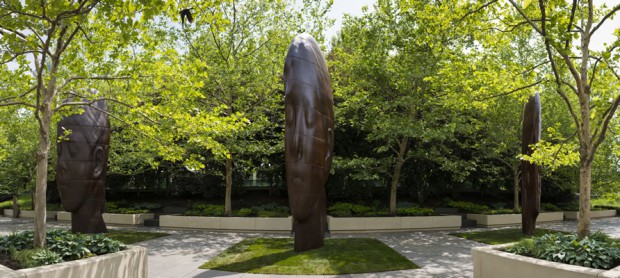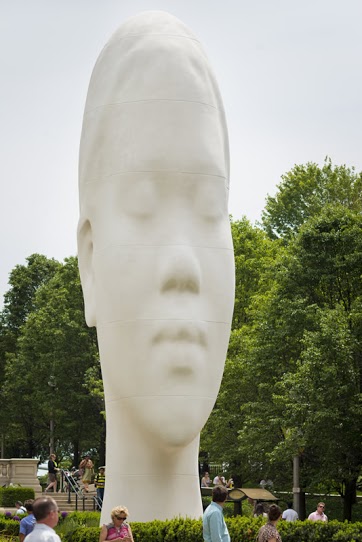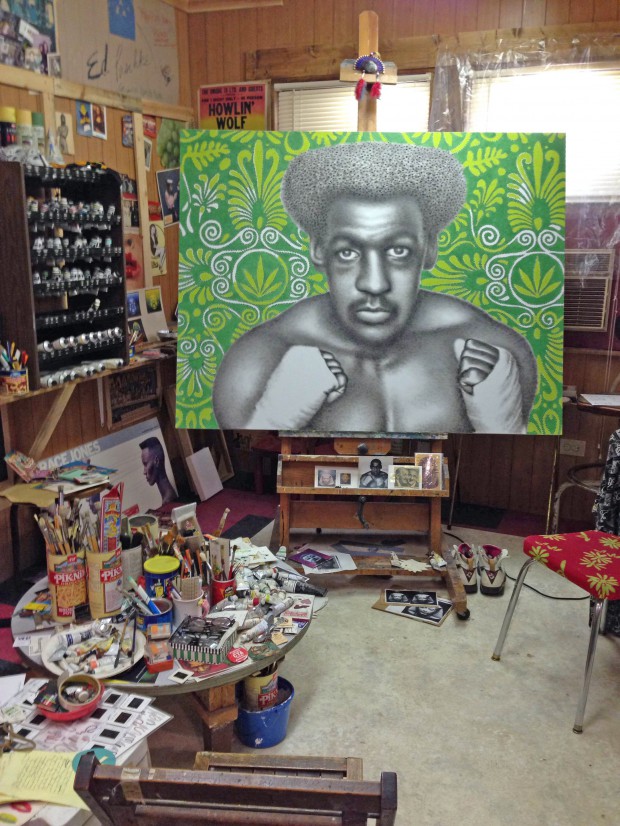CHICAGO – While the Chicago gallery scene mostly checks out for the summer, the city’s art museums and public arts programming tend to pick up the slack—and plenty of it is free and open everyday. In celebration of Millennium Park’s 10th anniversary, Spanish artist Jaume Plensa has been invited back to elaborate upon his famous Crown Fountain with enormous sculptures of young girls’ heads, while in the far Northwest neighborhood of Jefferson Park, the community-oriented Ed Paschke Art Center has just opened to the public.
Jaume Plensa: 1004 Portraits
Millennium Park
201 E Randolph St
Open daily, 6 AM – 11 PM
Iconic public artworks like Anish Kapoor’s Cloud Gate and Plensa’s massive video-based Crown Fountain have made downtown Chicago’s Millennium Park an essential part of the city’s image. Now, Chicago’s got more public art to talk about; building on Crown Fountain, which depicts a rotating series of 1,000 Chicagoans’ faces spouting streams of actual water from their mouths on two towering 50-foot screens, comes Plensa’s 1004 Portraits. These four large scale sculptures (unveiled June 18), are meant to be continuations of the 1,000 portraits depicted within the fountain.
These sculptures are precise, if expressionless, renderings of young girls’ heads, their faces calm with eyes closed. Three faces are rendered on flatted pieces of 20 foot high cast iron and installed adjacent to Plensa’s existing fountain, while a similar white, 40 feet high, sculpture greets visitors at the Madison Street entrance. They’re beautiful but blank. Plensa admits that these new sculptures are “more classical” than the new media of Crown Fountain. According to the artist, “there is some confusion as to what is interactive sculpture,” and he explains that while the fountain “creates a space,” the three cast iron works encourage viewers to activate the viewing experience by moving around the sculptures to appreciate the clever optical effect that appears to flatten and then re-volumize the faces as they walk around.
To some extent, Plensa’s explanation closes the conceptual gap between the fountain and the new sculptures, though when considering Millennium Park’s mission to be “an urban space of the future,” 1004 Portraits pales in comparison to the vibrancy and site specificity of the artist’s Crown Fountain. Compared to the animated video and water media of the neighboring fountain, Plensa’s new sculptures are static, and the people depicted in the fountain are far more expressive and individualized than the rather unspecific-looking children of the sculptures.
Just a mile up Michigan Avenue at Richard Gray Gallery, practically identical Plensa sculptures are for sale; these are just smaller, around 78” high. After viewing these pieces perfectly at home in the gallery, it’s hard not to feel disappointed at having the same experience of the work in the white cube as we do when it is inserted into the public space.
Ed Paschke Art Center
5415 W. Higgins Ave in Jefferson Park
Open 10 AM – 7 PM, Monday-Sunday
Free
At the entrance to the Ed Paschke Art Center exhibition space is a quote from Paschke in reference to his work: “They either love it or hate it but rarely are they indifferent to it.” He’s not kidding. One of Chicago’s most internationally famous artists, Paschke is known for creating works that elicit a response. Garish, sideshow-inspired nudes, images of violence and downright eerie characters are common in his oeuvre, as evidenced in works like Ramrod (1969) in which a male superhero poses in crotchless underwear, phallus hidden or removed, as twin Mighty Mouse figures hover on either side of his masked face.
Though Paschke’s more illicit pieces are not currently on display at the art center, in favor of a more family-friendly environment, visitors still waited in lines outside to get into the gallery on Sunday, June 22, the late artist’s 75th birthday, and the opening of the Ed Paschke Art Center. The space is much larger than its modest storefront makes it seem, a quality that had little effect on the crowds.
The EPAC is home to the largest collection of the artist’s work, and the inaugural exhibition features stunning examples from the Imagist’s entire career, from 1969 through his death in 2004. Standout works include Red Boxer (2004), a neon portrait of a young fighter on a floral ground (reminiscent of a Kehinde Wiley composition) created in the final year of the artists life, and bizarre, hologram-like “PHSCologram” self portraits from 2000. While for now, the space is all Paschke, the yet-to-be-announced exhibition schedule will feature local artists, and the art center will also house an artist in residence program.
Paschke’s unwavering aesthetic of neon colors, and often unnerving imagery evokes strong responses, though this survey provides a quite thorough insight into his long and productive career, no matter what the individual tastes of the viewer may be. His paintings sample from vernacular American culture, as well as references from Latin America and Asia. His work here is alternately weird and fun, as in Accordion Man (1969), with its subject rendered with a tiny shrunken head and outsized torso and hands, and then serious and political, like With God on Our Side 2 (2003) featuring an image of Osama Bin Laden peeking from behind layered panels of decorative patterns.
Upstairs, EPAC has installed a recreation of the artist’s studio, salvaged from his Howard Street space after his death in 2004. Here, late era paintings are placed upon easels amongst piles of studio ephemera like Pringles cans of tall brushes, old music and exhibition posters, sketches, reference material and bare stretcher bars. Much like a diorama in a history museum, viewers cannot enter the space, only peer inside it from behind waist-high walls. Displaying such a personal space as a deceased artist’s studio, with pairs of Paschke’s worn-in sneakers and his rumpled Hawaiian shirt thrown over a chair, is heart-warming, genuine and a little bit morbid, not unlike the sentiments that pervade the content of the artist’s works.
“It’s not as gritty as his Howard Street neighborhood,” remarked Chicago artist Sarah Krepp, a former student and contemporary of Paschke’s, “but he would have liked this.” Indeed, the residential neighborhood of Jefferson Park, far from Chicago’s established art districts, seems the ideal home for the art center. Paschke was born of Polish immigrant parents, and Jefferson Park with its diverse but still predominantly Polish culture provides a meaningful context through which to view his works in regards to his ethnic heritage.
The neighborhood appeared to be totally on board with the EPAC’s opening, hosting Ed Paschke-themed activities in the park next door. Folding tables of children’s crafts like neon paper collages, Lego renderings of Paschke paintings, and rainbow colored murals on insulation board swarmed with activity. Everyone took home free Ed Paschke coloring books and sugar cookies decorated with an image of his work. This sort of celebration, casual and low-brow, might not be appropriate in honoring just any artist, but for Paschke and his Chicago-style, vernacular pop, it works just fine.







Comments on this entry are closed.